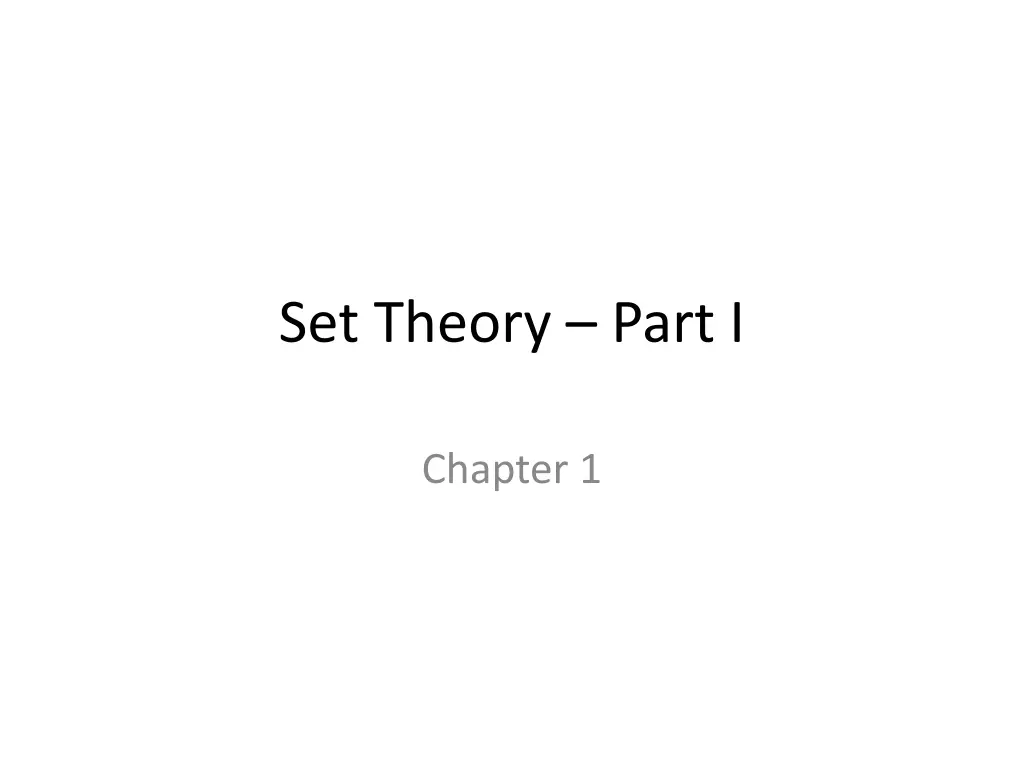
Introduction to Set Theory: Fundamentals and Notations
"Explore the foundational concepts of set theory, including definitions, properties, and operations on sets. Learn about the types of sets that commonly appear and their representations using set-builder notation. Dive into the world of sets, from basic elements to complex structures."
Download Presentation

Please find below an Image/Link to download the presentation.
The content on the website is provided AS IS for your information and personal use only. It may not be sold, licensed, or shared on other websites without obtaining consent from the author. If you encounter any issues during the download, it is possible that the publisher has removed the file from their server.
You are allowed to download the files provided on this website for personal or commercial use, subject to the condition that they are used lawfully. All files are the property of their respective owners.
The content on the website is provided AS IS for your information and personal use only. It may not be sold, licensed, or shared on other websites without obtaining consent from the author.
E N D
Presentation Transcript
Set Theory Part I Chapter 1
Set Theory Sets are fundamental discrete structures and for the basis of more complex discrete structures like graphs We will develop more fully The definitions of sets The properties of sets The operations on sets
Set Theory (Def:) A set is an (unordered) collection of unique objects. The objects in a set are called elements. One way to describe a set is to list its elements {0, 1, 2, 3, 4, 5, 6, 7, 8, 9} the set of digits {a, b, ...., x, y, z} the lower case alphabet set A set can be element of another set {{a,b, ...}, {0,1,2, ...., 9}, ... ,{ , , ....}, ....} set of all alphabets
Set Theory Notation, for a set A: x A: x is an element of A x A: x is not an element of A Conceptually, a set is like a bag containing objects. This bag can contain another bag containing other objects. Example: A= {1, {1}, {2}, {1,2}} How many elements are in A? 1 A? 2 A? {2} A? {{2}} A?
Set Theory Definition: Two sets, A and B, are equal if they contain the same elements. We write A=B. Example: {2,3,5,7}={3,2,7,5}, because a set is unordered Also, {2,3,5,7}={2,2,3,5,3,7} because a set contains unique elements However, {2,3,5,7} {2,3}
Special types of sets that come up often The empty set: ={} The natural numbers: N = {1, 2, 3, 4, .} The integers: Z = { ., -3, -2, -1, 0, 1, 2, 3, .} The rational numbers: Q = {1, , 1/3, , -1, -1/2, , 2, 2/3, , -2,-2/3, } The real numbers: R ={all real numbers on a number line} R
Representation of a set A set can be expressed by listing its elements between commas, enclosed by braces. {2, 4, 6, 8} (finite set) { ., -4, -3, -2, -1, 0, 1, 2, 3, 4, ..} (infinite set) {{a,b, ...}, {0,1,2, ...., 9}, ... ,{ , , ....}, ....}
Representation of a set A set-builder notation is used to describe sets that are too complex to enumerate them. Suppose E={ ., -6, -4, -2, 0, 2, 4, 6, .} Set-builder notation E={n : n is an even integer} or E={n | n is an even integer} Other examples A = {x : x is an integer |x| < 4} = {-3, -2, -1, 0, 1, 2, 3} The rational numbers: Q={x : x = m/n, m,n Z, n 0}
Some illustrations of set-builder notation
Equality of Sets, Subsets If B is a subset of A, every element of B is an element of A. We write B A. Two sets are equal if they have the same elements. To show that two sets are equal, it is sufficient to show separately that A B and B A
Equality of Sets, Subsets (contd.) Z+ is N, the set of natural numbers Q+ is the set of all positive rational numbers
Subsets (contd.) A set B is a proper subset of a set A, if it is a subset A and is not equal to A ( ). If A is a subset of B and B is a subset of C, A is a subset of C. (Transitive relation) Note that if A has at least one element, is a proper subset of A.
Cardinality of a set Cardinality of a set A, denoted by |A|: It is the number of elements in the set A set with finite number of elements is called a finite set. A set with infinite number of elements is called an infinite set. Sets N, Z, Q, R are all infinite. Empty set has no element, denoted by How many elements does the set { } contain?
Power set Given a set A, the power set of A, P(A), is the set of all subsets of A. Examples Let A={a,b,c}, P(A)={ ,{a},{b},{c},{a,b},{b,c},{a,c},{a,b,c}} Let A={{a,b},c}, P(A)={ ,{{a,b}},{c},{{a,b},c}} Note: the empty set and the set itself are always elements of the power set.
Power set The power set is a fundamental combinatorial object useful when considering all possible combinations of elements of a set Fact: Let S be a set such that |S|=n, then |P(S)| = 2n Some intuition?
Power set For B={1,2,3,4}
Ordered collection of objects Sometimes we need to consider ordered collection of objects. Consider a set S of points in the plane.
Ordered collection of objects Sometimes we need to consider ordered collection of objects. Consider a set S of points in the plane. pi =(xi,yi) is the x-y coordinate of the ith point. S={(x1,y1), (x2,y2), , (xm,ym)} represents a set of m ordered objects. Each object is an ordered collection of two elements. S = {p1,p2, , pm} is also fine.
Tuples Definition: The ordered n-tuple (a1,a2, ,an) is the ordered collection with the element ai being the ith element for i=1,2, ,n. Two ordered n-tuples (a1,a2, ,an) and (b1,b2, ,bn) are equal iff for every i=1,2, ,n we have ai=bi. A 2-tuple (n=2) is called an ordered pair.
Cartesian Product Definition: Let A and B be two sets. The Cartesian product of A and B, denoted AxB, is the set of all ordered pairs (a,b) where a A and b B AxB = { (a,b) | (a A) and (b B) } The Cartesian product is also known as the cross product. The name `Cartesian product comes from a geometric interpretation.
Cartesian Product A = B = R (the set of reals) R x R can also be written as R2.
Cartesian Product A = R (the set of reals), B = N (the set positive integers) = {1, 2, 3, }
Cartesian Product A = R (the set of reals), B = N (the set positive integers) = {1, 2, 3, } Note that A x B B x A, if A and B are not equal.
Cartesian Product A = B = N (the set positive integers) = {1, 2, 3, }
Cartesian Product A = B = N (the set positive integers) = {1, 2, 3, }
Cartesian Product Cartesian Products can be generalized for any n- tuple Definition: The Cartesian product of n sets, A1,A2, , An, denoted A1 A2 An, is A1 A2 An ={ (a1,a2, ,an) | ai Ai for i=1,2, ,n} Example: A set of points in three dimension with x- y-z coordinates. Each element of the set is an ordered 3-tuple.
Operations on Sets Let A and B be two arbitrary sets. Let U be the universal set, (i.e. A U and B U). Union: A B = {x: x A or x B} Intersection: A B = {x: x A and x B} Difference: A B = { x: x A and x B} Symmetric Difference: A B = {x: (x A and x B) or (x A and x B)} = (A B) (B A) Complement: U A = {x : x A}
Operations on Sets A={x2 : x R} B={ax + b : x R and a,b R}
Venn Diagram It is often used to visualize the various relations between the sets.
Intersection The intersection of sets A and B, denoted by A B, is the set that contains those elements in both A and B. U A B
Union The union of sets A and B, denoted by A B, is the set that contains those elements that are in either A or B. U A B
Set Difference Definition: The difference of two sets A and B, denoted A B, is the set containing those elements that are in A but not in B U A B
Set Complement Definition: The complement of a set A, denoted A, consists of all elements not in A. That is the difference of the universal set U and A. A = {x | x A } U A A
Disjoint Sets Definition: Two sets are said to be disjoint if their intersection is the empty set: A B = U A B


